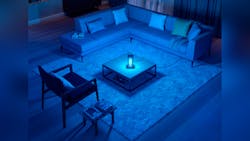Signify has revealed further erosion of its UV-C disinfection business, confirming to LEDs Magazine that it has withdrawn its Philips-branded goods from the consumer sector.
It will continue to market UV-C products in the professional sector, and will also provide non-Philips–branded products on an OEM basis for other vendors to sell under different labels.
But Eindhoven, Holland–based Signify has hit the end of the road for its own brand of UV-C wares in the consumer market. It exited quietly in December, some two-and-half years after marshalling significant resources across Asia, Europe, and North America to build and launch a range of 12 UV-C product families to combat the SARS-CoV-2 virus, which causes COVID-19.
“At the end of 2022, we discontinued sales to consumers of Philips-branded surface and air UV-C products,” a spokesperson told LEDs Magazine. “We are now focusing our UV-C efforts on disinfection in the B2B channel, where we see more structural demand for public health and hygiene solutions, and we continue to sell to our OEM customers.” (Signify, formerly Philips Lighting, still uses the Philips name across its entire product stable, be it general illumination, smart lighting, horticultural lightings, UV-C, or others).
When CEO Eric Rondolat ordered the UV-C ramp-up in June 2020, the COVID pandemic was in relatively early days and lockdowns were widespread. The UV-C products were intended to help eradicate the virus in homes, businesses, schools, retailers, theaters, and other public settings to help foster a return to normal. Signify built the units to emit 254-nm ultraviolet wavelengths — - a spectrum that resides in the shorter, or “C” range of UV, and which had earlier been proven to deactivate 99% of a sample of SARS-CoV-2 within 6 seconds.
Unfortunately for Signify and its well-intended public health and business decisions, the market has not materialized as well as it had anticipated.
Within a year or so after the UV-C launch, signs began emerging that sales were not going to plan. A big indication came in early August last year, when Rondolat told analysts on a second-quarter financial results call that Signify was declaring certain UV-C products as “obsolete” on the accounting books.
The affected products were those aimed at surface disinfection, which had fallen out of favor as scientific evidence increasingly indicated that the SARS-CoV-2 virus was spread primarily by airborne means.
Signify insisted at the time that, even though it had declared the surface products as obsolete — i.e., the company had written down their book value — it had not “discontinued” them. Rather, it was continuing to sell them — presumably to clear out stock.
As recently as November, Signify reiterated to LEDs that it had not discontinued any products, although it acknowledged that demand had declined for all of its types of UV-C products, including those for air as well as surface and object disinfection.
But that has now changed, with the withdrawal from the consumer market.
It is not clear how financially costly the underperforming UV-C market has been, or the extent to which it contributed to a recent fourth-quarter decline of 8.8% in corporate sales, a 49.5% plunge in net income, and reluctance by Rondolat to commit to a 2023 sales forecast.
Signify informed LEDs of the consumer withdrawal after we asked for a UV-C update following a web call with analysts last Friday to discuss the fourth-quarter results. The company did not discuss UV-C sales during the call. We will bring you more on this story as we get it.
MARK HALPER is a contributing editor for LEDs Magazine, and an energy, technology, and business journalist ([email protected]).
For up-to-the-minute LED and SSL updates, follow us on Twitter. You’ll find curated content and commentary, as well as information on industry events, webcasts, and surveys on our LinkedIn page and our Facebook page.





